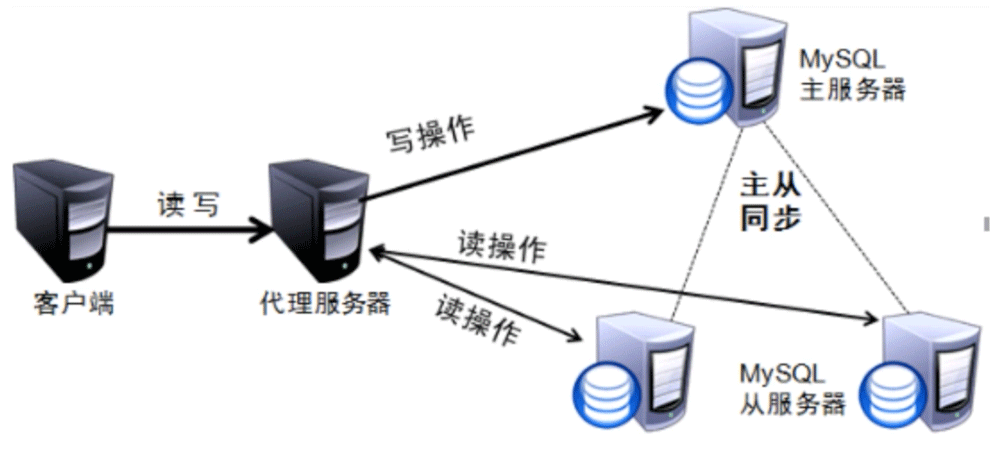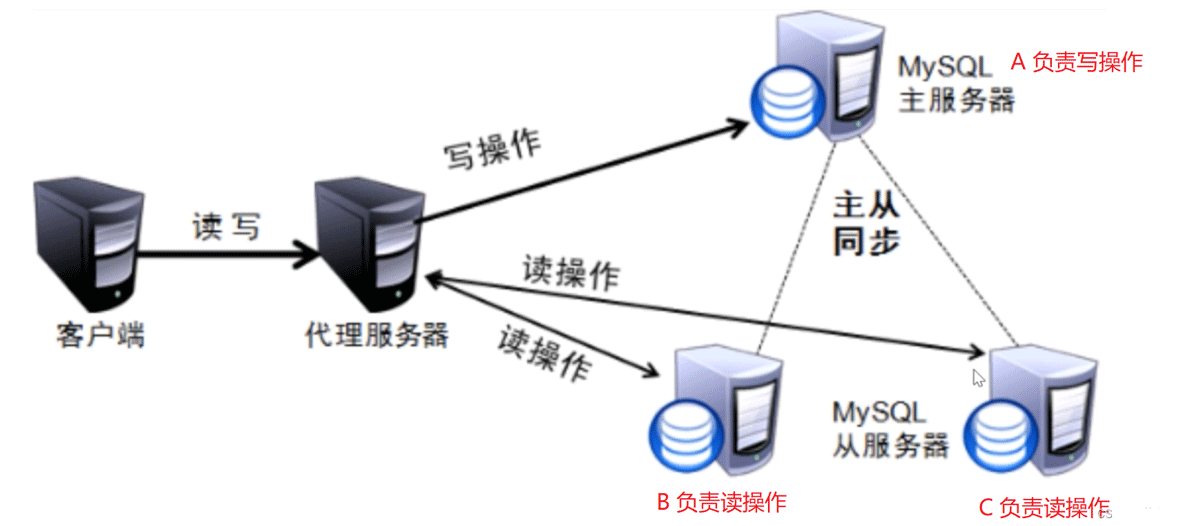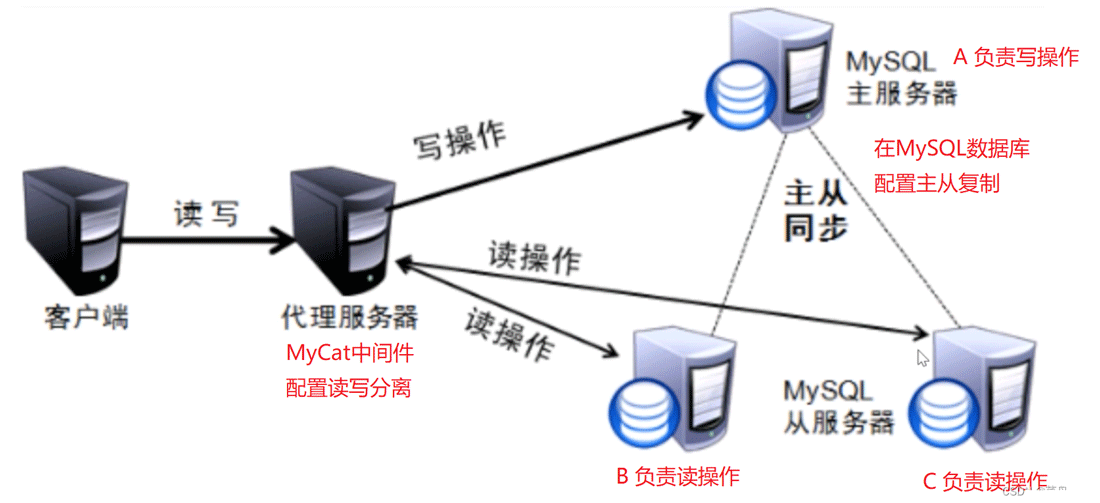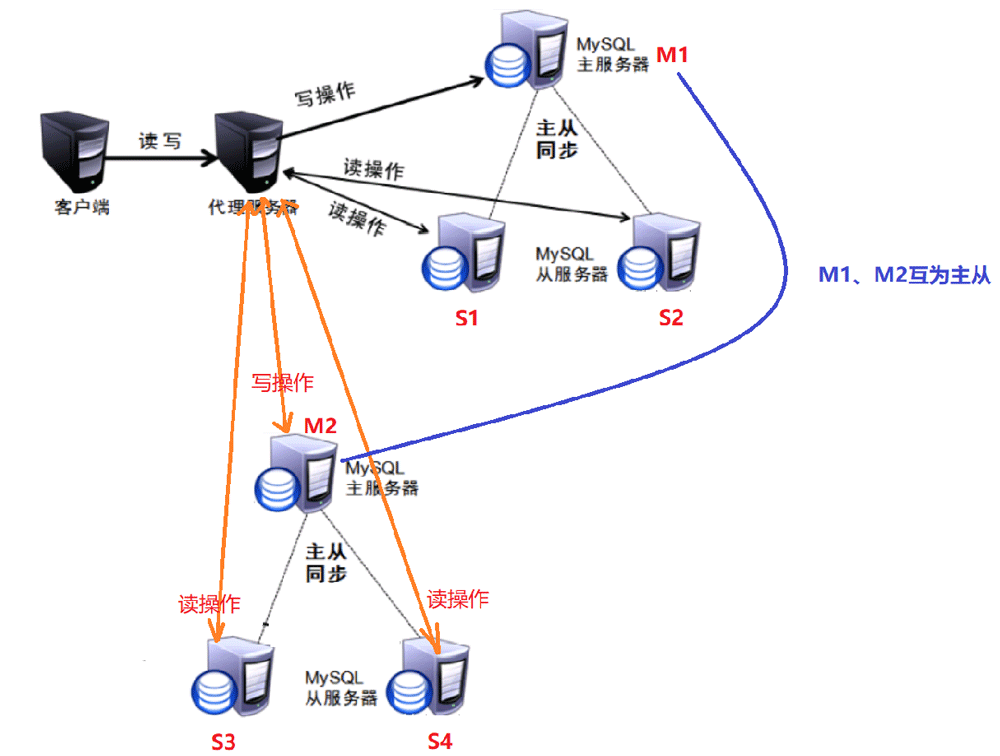What is the principle of MySQL read and write separation?
1. The concept of read-write separation
Read-write separation is implemented based on master-slave replication. In an actual application environment, there must be a lot of read operations. Just like when we buy something on an e-commerce platform, we may only buy one or two after looking at 100 items. Therefore, there are always many more read operations than write update operations. Therefore, our read-write separation configuration based on master-slave replication means that a master database is dedicated to modifying data. When writing, it is written exclusively on the master database. The master database synchronizes data changes to the slave through master-slave replication through binlog. library, then other client query requests will eventually be mapped to the slave library, and we have one main library with two or three slave libraries. The main library is specially used for data updates (write operations), and the slave library The library is specially used for read operations. This way, the pressure of reading and writing can be well distributed. It does not need to be concentrated on the main library. It greatly improves the concurrent processing capabilities of back-end services. In addition, it has high availability capacity. In case of disaster, when the main database fails, the designated slave database can be turned into the main database.

MySQL client communicates with MySQL Server through the API provided by mysql and uses mysql's customized TCP-based data protocol (referred to as the mysql protocol) to access the MySQL Server database. .
If there is only one server (stand-alone environment), all data additions, deletions, modifications and queries are performed on one server. As our services are used by more and more people, the traffic gradually increases. Concurrency capabilities need to be gradually improved, so if we find that database performance has reached a bottleneck, we can perform read-write separation operations to improve background services.

The MySQL main server in the picture is dedicated to write operations. There are two MySQL slave servers connected below to specifically perform read operations. Read requests are forwarded to B and C, and write requests are forwarded. to A.
If we write code directly on the client, write operations such as insert and update are done on A, and read operations such as show and select are done on B and C. This is equivalent to the code and master-slave environment. Strongly bound. This leads to poor stability of the code, because it is strongly related to the environment. When we write code, we must know which machine is the main library responsible for writing operations, and which machine is the slave library responsible for reading operations. The code chooses . At this time, if a certain machine hangs up, the code will not know it and will still forward the request in the original way, and communication problems will occur. Therefore, it is definitely not appropriate to implement the separation of reading and writing in code. So in the actual solution, reading and writing separation needs to rely on the middleware of the database.
2. Introduce the middleware MyCat
In fact, the separation of reading and writing, and sub-database and table sub-reliance need to rely on the database middleware (mycat), which is the role of the proxy server.

The client cannot actually tell whether it is connected to MyCat or MySQL, because the communication follows the MySQL communication protocol. How to communicate with MySQL before, how to communicate with MySQL now? MyCat communicates, so there is no need to distinguish.
Configuring read-write separation on MyCat, we do not need to make any changes to the code on the client. There is no need to distinguish which request is for reading and which is for writing in the code. The code accesses directly The one is MyCat, which parses the request and forwards it to the server responsible for the corresponding operation according to the read and write nature of SQL to achieve read and write separation.
You need to configure the information of the master server and slave servers on MyCat. There are three situations: One master and one slave, one master and multiple slaves, and multiple masters and multiple slaves
One master and multiple slaves scenario: When the writing library (master) hangs up, MyCat can also immediately turn a slave library (slave) directly into a writing library (master), which is equivalent to returning to a writing library (master). For machine processing, because there is no master-slave replication configuration between the slave library and the slave library, we also need to configure the master-slave replication between the slave library that becomes the writing library and other slave libraries.
Multiple masters and multiple slaves:

As you can see in the picture, the MyCat server has two sets of environments. If one of them The main database is down (its corresponding slave database is also unavailable). At this time, MyCat will automatically switch to another environment, because M1 and M2 are also configured as mutual masters and slaves, so M2 can synchronize the data of M1 and provide exactly the same services as the M1 environment, so its high availability and disaster recovery capabilities are very good.
3. MyCat service port and management port
MySQL service port is 3306, MyCat service port is 8066 (this port can also be changed), which is MySQL The Client connects to port 8066. The interface you see when logging in to port 8066 is the same as logging in to port 3306 of MySQL Server. MyCat also has a management port 9066. You can log in to this management port to view all the status of MyCat's work and the connection to the back-end server, as well as the status of the connection to the data source.
The above is the detailed content of What is the principle of MySQL read and write separation?. For more information, please follow other related articles on the PHP Chinese website!

Hot AI Tools

Undresser.AI Undress
AI-powered app for creating realistic nude photos

AI Clothes Remover
Online AI tool for removing clothes from photos.

Undress AI Tool
Undress images for free

Clothoff.io
AI clothes remover

Video Face Swap
Swap faces in any video effortlessly with our completely free AI face swap tool!

Hot Article

Hot Tools

Notepad++7.3.1
Easy-to-use and free code editor

SublimeText3 Chinese version
Chinese version, very easy to use

Zend Studio 13.0.1
Powerful PHP integrated development environment

Dreamweaver CS6
Visual web development tools

SublimeText3 Mac version
God-level code editing software (SublimeText3)

Hot Topics
 1670
1670
 14
14
 1428
1428
 52
52
 1329
1329
 25
25
 1274
1274
 29
29
 1256
1256
 24
24
 Laravel Introduction Example
Apr 18, 2025 pm 12:45 PM
Laravel Introduction Example
Apr 18, 2025 pm 12:45 PM
Laravel is a PHP framework for easy building of web applications. It provides a range of powerful features including: Installation: Install the Laravel CLI globally with Composer and create applications in the project directory. Routing: Define the relationship between the URL and the handler in routes/web.php. View: Create a view in resources/views to render the application's interface. Database Integration: Provides out-of-the-box integration with databases such as MySQL and uses migration to create and modify tables. Model and Controller: The model represents the database entity and the controller processes HTTP requests.
 MySQL and phpMyAdmin: Core Features and Functions
Apr 22, 2025 am 12:12 AM
MySQL and phpMyAdmin: Core Features and Functions
Apr 22, 2025 am 12:12 AM
MySQL and phpMyAdmin are powerful database management tools. 1) MySQL is used to create databases and tables, and to execute DML and SQL queries. 2) phpMyAdmin provides an intuitive interface for database management, table structure management, data operations and user permission management.
 MySQL vs. Other Programming Languages: A Comparison
Apr 19, 2025 am 12:22 AM
MySQL vs. Other Programming Languages: A Comparison
Apr 19, 2025 am 12:22 AM
Compared with other programming languages, MySQL is mainly used to store and manage data, while other languages such as Python, Java, and C are used for logical processing and application development. MySQL is known for its high performance, scalability and cross-platform support, suitable for data management needs, while other languages have advantages in their respective fields such as data analytics, enterprise applications, and system programming.
 Laravel framework installation method
Apr 18, 2025 pm 12:54 PM
Laravel framework installation method
Apr 18, 2025 pm 12:54 PM
Article summary: This article provides detailed step-by-step instructions to guide readers on how to easily install the Laravel framework. Laravel is a powerful PHP framework that speeds up the development process of web applications. This tutorial covers the installation process from system requirements to configuring databases and setting up routing. By following these steps, readers can quickly and efficiently lay a solid foundation for their Laravel project.
 Explain the purpose of foreign keys in MySQL.
Apr 25, 2025 am 12:17 AM
Explain the purpose of foreign keys in MySQL.
Apr 25, 2025 am 12:17 AM
In MySQL, the function of foreign keys is to establish the relationship between tables and ensure the consistency and integrity of the data. Foreign keys maintain the effectiveness of data through reference integrity checks and cascading operations. Pay attention to performance optimization and avoid common errors when using them.
 Compare and contrast MySQL and MariaDB.
Apr 26, 2025 am 12:08 AM
Compare and contrast MySQL and MariaDB.
Apr 26, 2025 am 12:08 AM
The main difference between MySQL and MariaDB is performance, functionality and license: 1. MySQL is developed by Oracle, and MariaDB is its fork. 2. MariaDB may perform better in high load environments. 3.MariaDB provides more storage engines and functions. 4.MySQL adopts a dual license, and MariaDB is completely open source. The existing infrastructure, performance requirements, functional requirements and license costs should be taken into account when choosing.
 What software is better for yi framework? Recommended software for yi framework
Apr 18, 2025 pm 11:03 PM
What software is better for yi framework? Recommended software for yi framework
Apr 18, 2025 pm 11:03 PM
Abstract of the first paragraph of the article: When choosing software to develop Yi framework applications, multiple factors need to be considered. While native mobile application development tools such as XCode and Android Studio can provide strong control and flexibility, cross-platform frameworks such as React Native and Flutter are becoming increasingly popular with the benefits of being able to deploy to multiple platforms at once. For developers new to mobile development, low-code or no-code platforms such as AppSheet and Glide can quickly and easily build applications. Additionally, cloud service providers such as AWS Amplify and Firebase provide comprehensive tools
 SQL vs. MySQL: Clarifying the Relationship Between the Two
Apr 24, 2025 am 12:02 AM
SQL vs. MySQL: Clarifying the Relationship Between the Two
Apr 24, 2025 am 12:02 AM
SQL is a standard language for managing relational databases, while MySQL is a database management system that uses SQL. SQL defines ways to interact with a database, including CRUD operations, while MySQL implements the SQL standard and provides additional features such as stored procedures and triggers.




